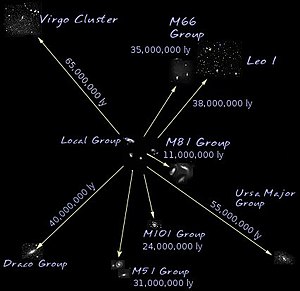Virgo Supercluster
The Virgo Supercluster (Virgo SC) or Local Supercluster is the large galaxy cluster that contains the Virgo Cluster and the Local Group.[1] At least 100 galaxies and clusters are in it.

The diameter of Virgo SC is 33 megaparsecs (110 million light-years). It is one of millions of superclusters in the observable universe.
Background
changeWhen the first large sample of nebulae was published by William and John Herschel in 1863, it was seen that there is a marked excess of nebular fields in the constellation Virgo (near the north galactic pole).
In the 1950s, it was suggested that this excess was a large-scale galaxy-like structure, a "Local Supercluster".[2][3] Debate went on during the 1960s and 1970s as to whether the Local Supercluster (LS) was actually a structure or a chance alignment of galaxies.[4] The issue was resolved with the large redshift surveys of the late 1970s and early 1980s, which showed a flattened concentration of galaxies along the supergalactic plane.[5]
Structure
changeIn 1982 R. Brent Tully showed it consists of two components: a flattened disk with two-thirds of the supercluster's luminous galaxies, and a roughly spherical halo containing the remaining one-third.[6] The disk itself is a thin (~1 megaparsecs) ellipsoid with a long axis / short axis ratio of at least 6 to 1, and possibly as high as 9 to 1.[7]
Data released in June 2003 from a redshift survey lets astronomers compare the LS to other superclusters. The LS represents a typical poor (that is, it lacks a high density core) supercluster of rather small size. It has one rich galaxy cluster in the center, surrounded by filaments of galaxies and poor groups.[8]
The Local Group is on the outskirts of the LS in a small filament extending from the Fornax Cluster to the Virgo Cluster.[5] The Virgo Supercluster's volume is about 7000 times that of the Local Group or 100 billion times that of the Milky Way.
References
change- ↑ The Local Group contains the Milky Way and Andromeda galaxies.
- ↑ cfa.harvard.edu, The geometry of the Local Supercluster, John P. Huchra, 2007 (accessed 12-12-2008)
- ↑ Shapley, Harlow 1959. Of stars and men.
- ↑ de Vaucouleurs G. (1981). "The Local Supercluster of Galaxies". Bulletin of the Astronomical Society of India. 9: 6 (see note). Bibcode:1981BASI....9....1D.
- ↑ 5.0 5.1 Klypin, Anatoly; et al. (2003). "Constrained simulations of the real universe: the Local Supercluster". The Astrophysical Journal. 596 (1): 19–33. arXiv:astro-ph/0107104. Bibcode:2003ApJ...596...19K. doi:10.1086/377574. S2CID 1830859.
- ↑ Hu F.X.; et al. (2006). "Orientation of galaxies in the Local Supercluster: a review". Astrophysics and Space Science. 302 (1–4): 43–59. arXiv:astro-ph/0508669. Bibcode:2006Ap&SS.302...43H. doi:10.1007/s10509-005-9006-7. S2CID 18837475.
- ↑ Tully R.B. (1982). "The Local Supercluster". Astrophysical Journal. 257 (1): 389–422. Bibcode:1982ApJ...257..389T. doi:10.1086/159999.
- ↑ Einasto M.; et al. (2007). "The richest superclusters. I. Morphology". Astronomy and Astrophysics. 476 (2): 697–711. arXiv:0706.1122. Bibcode:2007A&A...476..697E. doi:10.1051/0004-6361:20078037. S2CID 15004251.